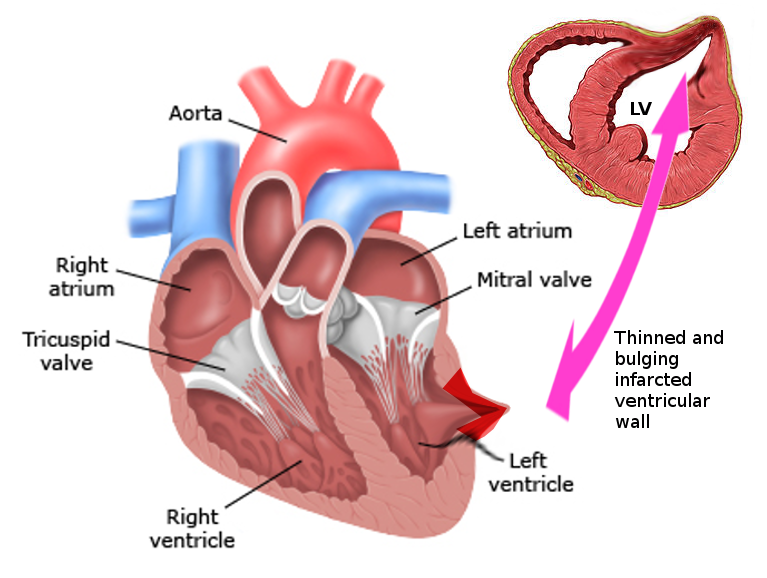[1]
Frances C, Romero A, Grady D. Left ventricular pseudoaneurysm. Journal of the American College of Cardiology. 1998 Sep:32(3):557-61
[PubMed PMID: 9741493]
[2]
Krawczyk-Ożóg A,Sorysz D,Dziewierz A,Rajtar-Salwa R,Daniec M,Dudek D, Apical pseudoaneurysm after transapical transcatheter aortic valve implantation. Polish archives of internal medicine. 2018 Jan 31;
[PubMed PMID: 29219144]
[3]
Katada Y,Ito J,Shibayama K,Nakatsuka D,Kawano Y,Watanabe H,Tabata M, Transapical Transcatheter Closure of the Pseudoaneurysm in the Left Ventricular Outflow Tract After Aortic Valve Replacement. JACC. Cardiovascular interventions. 2016 Sep 26;
[PubMed PMID: 27592012]
[4]
Van Tassel RA,Edwards JE, Rupture of heart complicating myocardial infarction. Analysis of 40 cases including nine examples of left ventricular false aneurysm. Chest. 1972 Feb
[PubMed PMID: 5058893]
Level 3 (low-level) evidence
[5]
Sakai K,Nakamura K,Ishizuka N,Nakagawa M,Hosoda S, Echocardiographic findings and clinical features of left ventricular pseudoaneurysm after mitral valve replacement. American heart journal. 1992 Oct
[PubMed PMID: 1529909]
[6]
Yeo TC, Malouf JF, Oh JK, Seward JB. Clinical profile and outcome in 52 patients with cardiac pseudoaneurysm. Annals of internal medicine. 1998 Feb 15:128(4):299-305
[PubMed PMID: 9471934]
[7]
Prêtre R,Linka A,Jenni R,Turina MI, Surgical treatment of acquired left ventricular pseudoaneurysms. The Annals of thoracic surgery. 2000 Aug
[PubMed PMID: 10969679]
[8]
Perek B,Jemielity M,Dyszkiewicz W, Clinical profile and outcome of patients with chronic postinfarction left ventricular false aneurysm treated surgically. The heart surgery forum. 2004 Apr 1
[PubMed PMID: 15138090]
[9]
Clift P,Thorne S,de Giovanni J, Percutaneous device closure of a pseudoaneurysm of the left ventricular wall. Heart (British Cardiac Society). 2004 Oct
[PubMed PMID: 15367535]
[10]
Okuyama K,Chakravarty T,Makkar RR, Percutaneous transapical pseudoaneurysm closure following transcatheter aortic valve replacement. Catheterization and cardiovascular interventions : official journal of the Society for Cardiac Angiography
[PubMed PMID: 27619932]
[11]
Kadner A,Fasnacht M,Kretschmar O,Prêtre R, Traumatic free wall and ventricular septal rupture - 'hybrid' management in a child. European journal of cardio-thoracic surgery : official journal of the European Association for Cardio-thoracic Surgery. 2007 May;
[PubMed PMID: 17337199]
[12]
Srivastava NT,Hoyer MH, Thromboexclusion of an atypical left ventricular pseudoaneurysm. Catheterization and cardiovascular interventions : official journal of the Society for Cardiac Angiography
[PubMed PMID: 24824727]
[13]
Acharya D,Nagaraj H,Misra VK, Transcatheter closure of left ventricular pseudoaneurysm. The Journal of invasive cardiology. 2012 Jun;
[PubMed PMID: 22684390]
[14]
Ussia GP,Cammalleri V,De Vico P,Sergi D,Romeo F, Transcatheter closure of paravalvular leak secondary to left ventricular peri-annular pseudoaneurysm. European heart journal cardiovascular Imaging. 2013 Jun;
[PubMed PMID: 23288889]
[15]
Mendiz O,Fava C,Cerda M,Lev G,Caponi G,Valdivieso L, Percutaneous repair of left ventricular pseudoaneurysm after transcatheter aortic valve replacement. Cardiovascular revascularization medicine : including molecular interventions. 2017 Sep;
[PubMed PMID: 28262477]
[16]
Sawlani N,Berry N,Sobieszczyk P,Kaneko T,Pelletier M,Shah P, Percutaneous Closure of a Delayed Left Ventricular Pseudoaneurysm After Transseptal Transcatheter Mitral Valve Replacement. JACC. Cardiovascular interventions. 2017 Jul 24;
[PubMed PMID: 28668314]
[17]
Madan T,Juneja M,Raval A,Thakkar B, Transcatheter device closure of pseudoaneurysms of the left ventricular wall: An emerging therapeutic option. Revista portuguesa de cardiologia : orgao oficial da Sociedade Portuguesa de Cardiologia = Portuguese journal of cardiology : an official journal of the Portuguese Society of Cardiology. 2016 Feb;
[PubMed PMID: 26852302]

